|
Fine Glassware for the
Table
by Bob Brooke
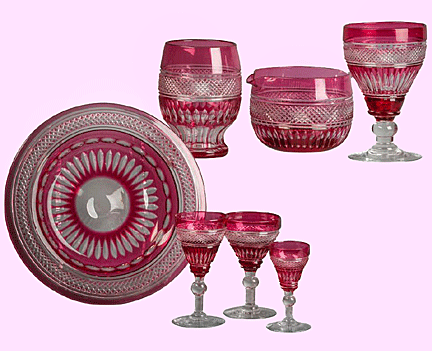 Wealthy
Victorians set their elaborate dinner tables with crystal glassware. A
typical place setting could have as many as six glasses, each for a
different use. And though that style of dining didn’t persist too far
into the future, the elegance that crystal tableware brought to the
table lived on well into the 1950s and 1960s as the American middle
class became more affluent. Wealthy
Victorians set their elaborate dinner tables with crystal glassware. A
typical place setting could have as many as six glasses, each for a
different use. And though that style of dining didn’t persist too far
into the future, the elegance that crystal tableware brought to the
table lived on well into the 1950s and 1960s as the American middle
class became more affluent.
Augustus H. Heisey founded Heisey Glass in 1896 with one 16-pot furnace,
after running the George Duncan & Sons factory in Pittsburgh for several
years. He chose Newark, Ohio, as the location of his new
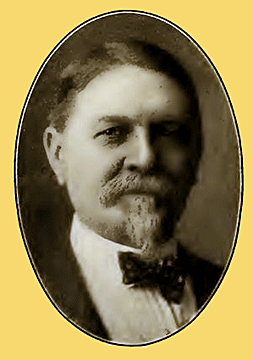 company
because of the abundance of natural resources. In the beginning, the
30,000-square foot factory employed about 200 people. The factory
eventually had three furnaces and employed nearly 850 people. company
because of the abundance of natural resources. In the beginning, the
30,000-square foot factory employed about 200 people. The factory
eventually had three furnaces and employed nearly 850 people.
During its early years, Heisey confined production to pressed ware, much
of it of such fine quality and sharpness of design that it appeared to
be cut. It also made glassware used in hotels and bars.
The company also produced blown glassware in a wide variety of patterns
and colors. High clarity and brilliance were the hallmarks of Heisey
glass. Workers highly finished pieces using a process called
firepolishing. Many of the pressed pieces appear to be cut crystal on
casual inspection, due to the high quality of the glass and the
crispness of the molding.
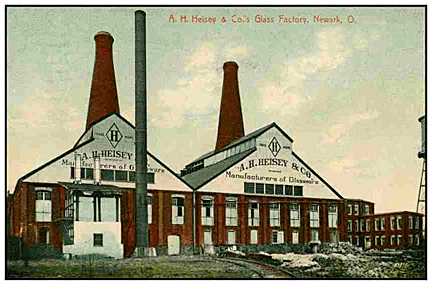
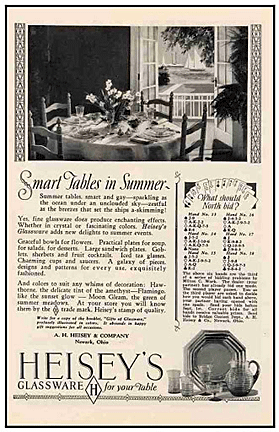 In
1914 the company began to make blown ware which it called “Heisey’s
American Crystal.” Not content with traditional pulled stemware, they
became the first glass company to make fancy pressed stems. In
1914 the company began to make blown ware which it called “Heisey’s
American Crystal.” Not content with traditional pulled stemware, they
became the first glass company to make fancy pressed stems.
Heisey was one of the first glass houses to advertise nationally, using
its ads to introduce and sell a varied spectrum of colored tableware as
early as 1910. By coordinating its pieces to follow decorating trends,
Heisey was able not only to make colored tableware acceptable. Heisey
ads appeared in Better Homes & Gardens, McCall's, Cosmopolitan, Ladies
Home Journal and-National Geographic.
The company’s main competition came from Cambridge and Duncan & Miller
tableware and Fostoria stemware, but the Heisey and Fostoria ads never
appeared in the same issue of a magazine.
The Heisey Trademark
In late 1900, one of Augustus’ sons, George Duncan Heisey, designed the
famous Heisey trademark, an “H” within a diamond. Heisey insisted that
all of the company’s glass be marked. But later on, less of it was.
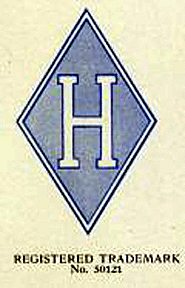 The
trademark can usually be found on the bottom of molded Heisey pieces, on
'the necks of cruets and sometimes even in inconspicuous places like
under a handle. Some trademarks can be found near the rims of bowls as
well as under feet or on the sides of some pieces. The
trademark can usually be found on the bottom of molded Heisey pieces, on
'the necks of cruets and sometimes even in inconspicuous places like
under a handle. Some trademarks can be found near the rims of bowls as
well as under feet or on the sides of some pieces.
The lack of the trademark on a piece of glass doesn’t necessarily mean
it’s not Heisey. The company didn’t begin using this trademark until
November 1, 1900, so pieces made in the four years prior to that date
had no marks.
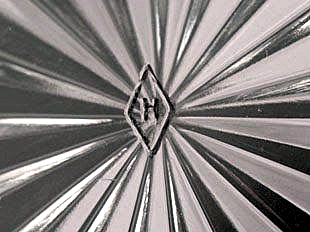 Sometimes
a piece won't carry the mark because the Diamond H, which was cut into
the mold for pressed wares, became worn. Worn molds were replaced, but
sometimes without the Diamond H. Also, the process of fire polishing
often eliminated all or part of the Diamond H. Heisey trademarked its
pieces in the molding process, so handblown wares never had the Diamond
H mark. Sometimes
a piece won't carry the mark because the Diamond H, which was cut into
the mold for pressed wares, became worn. Worn molds were replaced, but
sometimes without the Diamond H. Also, the process of fire polishing
often eliminated all or part of the Diamond H. Heisey trademarked its
pieces in the molding process, so handblown wares never had the Diamond
H mark.
Heisey Colors
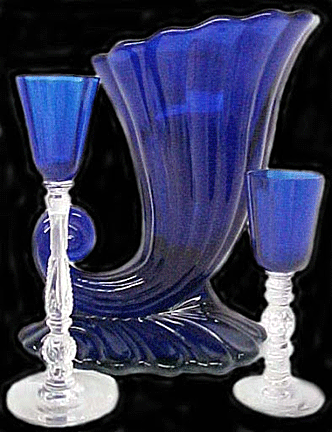 Heisey
produced glass in colors, most of which was from 1925 to 1938. The
company went to great lengths to produce distinct colors, and Heisey
glass may often be identified from specific colors alone. In 1925, it
introduced Flamingo, a pastel rose-pink, and Moongleam, a vivid green,
producing both in large quantities. Marigold was a brassy gold-yellow
color. Sahara, which replaced Marigold, was a soft lemony yellow while
Hawthorne was a shade of lavender. Tangerine, a bright orange-red
produced from about 1933, was part of a trend to darker, more vivid
colors. During this time, Heisey produced a cobalt color which it called
Stiegel Blue. The rarest of Heisey colors was Alexandrite, which could
appear as a pale blue-green under normal light, but in sunlight or
ultraviolet light, it glowed with a pink-lavender hue. The last new
color introduced by the company was Zircon, a modern grey-blue. Heisey
produced glass in colors, most of which was from 1925 to 1938. The
company went to great lengths to produce distinct colors, and Heisey
glass may often be identified from specific colors alone. In 1925, it
introduced Flamingo, a pastel rose-pink, and Moongleam, a vivid green,
producing both in large quantities. Marigold was a brassy gold-yellow
color. Sahara, which replaced Marigold, was a soft lemony yellow while
Hawthorne was a shade of lavender. Tangerine, a bright orange-red
produced from about 1933, was part of a trend to darker, more vivid
colors. During this time, Heisey produced a cobalt color which it called
Stiegel Blue. The rarest of Heisey colors was Alexandrite, which could
appear as a pale blue-green under normal light, but in sunlight or
ultraviolet light, it glowed with a pink-lavender hue. The last new
color introduced by the company was Zircon, a modern grey-blue.
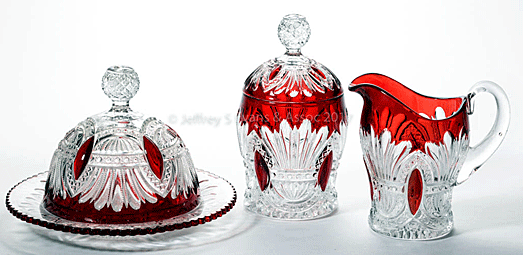
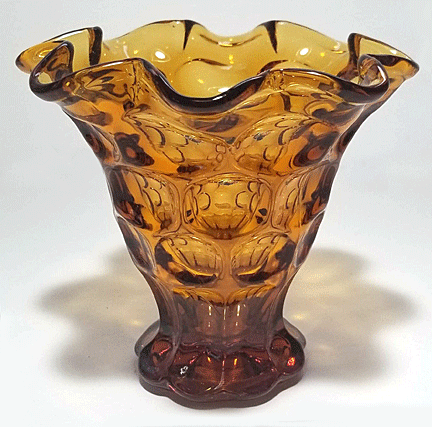 The
company produced some colors, like Amber, to fill custom orders. And it
referred to its vaseline glass as Canary. Emerald was a beautiful green,
sometimes found in pieces decorated with gold rims. Ivory and Ivorina
Verde, both made from 1897 to 1910, were Heisey's names for what’s now
commonly known as custard glass. Ivory was the name given to the
lightest shades and Ivorina Verde to the darkest. The
company produced some colors, like Amber, to fill custom orders. And it
referred to its vaseline glass as Canary. Emerald was a beautiful green,
sometimes found in pieces decorated with gold rims. Ivory and Ivorina
Verde, both made from 1897 to 1910, were Heisey's names for what’s now
commonly known as custard glass. Ivory was the name given to the
lightest shades and Ivorina Verde to the darkest.
Heisey also produced glassware in several experimental colors. Black
appeared in the early 1930s and possibly again in the mid 1950s. Dawn,
produced from 1955 to1957, was a gray color; which looks like amethyst
in natural light. Light blue was only produced in limited quantities in
1932. Gold Ruby was similar to cranberry and made only in 1932.
Popular Heisey Patterns
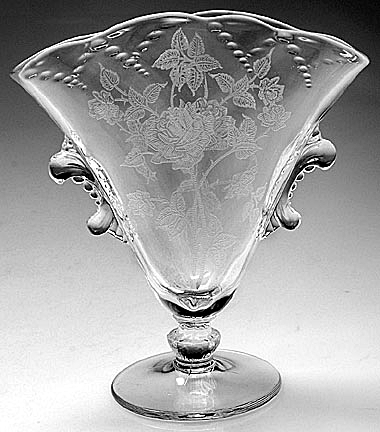 Heisey
often used a single shape for more than one pattern. The undecorated
wares, or blanks, might be sold as they were, and also etched with one
or more designs to make up additional lines. Heisey's Rose and Orchid
patterns, for instance, were names Heisey gave to etchings applied to
crystal pieces in the Waverly shape. Both were popular with
brides-to-be. Heisey
often used a single shape for more than one pattern. The undecorated
wares, or blanks, might be sold as they were, and also etched with one
or more designs to make up additional lines. Heisey's Rose and Orchid
patterns, for instance, were names Heisey gave to etchings applied to
crystal pieces in the Waverly shape. Both were popular with
brides-to-be.
Popular pattern names included Crystolite, Greek Key, Empress,
Plantation, Ridgeleigh, Stanhope, Old Sandwich, Octagon, Yeoman, and
Victorian, a square block pattern found mostly in crystal, among dozens
of others.
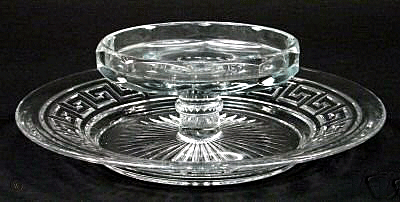
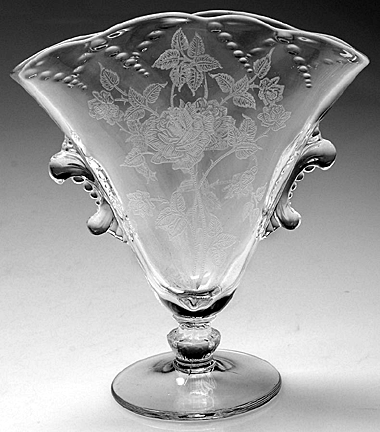 n
the late 1890s, Heisey revived the colonial patterns with flutes,
scallops and panels which had been so popular earlier in the century.
These were so well accepted that from that time on, at least one
colonial line was made continuously until the factory closed. n
the late 1890s, Heisey revived the colonial patterns with flutes,
scallops and panels which had been so popular earlier in the century.
These were so well accepted that from that time on, at least one
colonial line was made continuously until the factory closed.
Heisey made far more crystal than colored glass, and prices for colored
pieces are often higher than their crystal counterparts. In addition to
adding value, Heisey colors can provide clues for dating a piece,
especially when combined with information about when the pattern first
appeared.
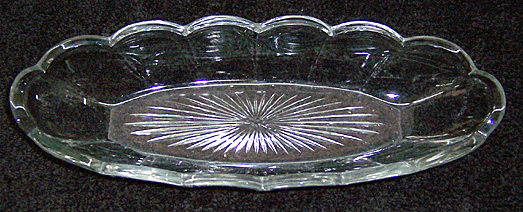
Though the company closed its doors in 1957, it didn’t shut down its
furnaces until May, 1958, in hopes that it might make another go of it.
But that never happened. At the time the factory closed, the Imperial
Glass Company bought the molds for the Heisey glass production and
continued producing some pieces mostly with the Imperial Glass mark
until they went out of business in 1984.
< Back
to Collectibles Archives
Next Article >
|
